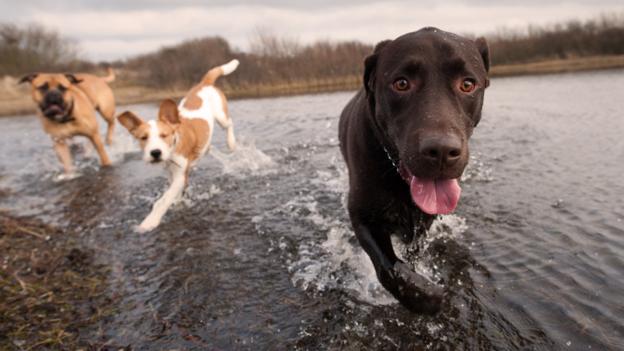Why do animals like to play?

(Copyright: Thinkstock)
Recreation may look like it serves no obvious purpose, but when dogs
and other animals are having fun they are learning some valuable
lessons.
Say
you're walking your dog in the park, when he comes face to snout with
another dog. An intricate dance begins, as if each movement was
precisely choreographed. The dogs visually inspect each other, sniff
each other, walk circles around each other. And then the fight begins.
But is it really a fight, or is it just play-fighting? It's very
important for Fido and you to know whether he's in any true danger.Dog owners everywhere like to take their dogs to the park to play. But is their behaviour best described as "play"? Scientists, such as James L. Gould and Carol Grant Gould have used the word “play” to describe any behaviour that does not have any apparent adaptive function, that is, it serves no obvious purpose.
The natural world teems with examples of such "purposeless activities." University of Vermont biologists Bernd Heinrich and Rachel Smolker describe a commonplace activity among ravens (Corvus corax): snowboarding. Ravens in Alaska and Northern Canada are known to slide down steep, snow-covered roofs. When they reach the bottom, they walk or fly back to the top, and repeat the process over and over again. In Maine, ravens were observed tumbling down small mounds of snow, sometimes while holding sticks between their talons. "We see no obvious utilitarian function for sliding behaviour," they write. Anyone who has spent time in a school playground will recognize that ravens and human children both delight in this type of repetitive sliding activity.
Herring gulls (Larus argentatus), too, like to play, but it’s not them that take any risks. These shorebirds feed on clams by dropping them onto hard surfaces such as rocks or paved roads. If they drop them from high enough, the clamshell might crack, providing access to the juicy snack waiting inside. Sometimes, rather than letting clams drop to the ground, herring gulls try to catch the clam in mid-air. Other shorebirds play this game of catch as well, including black-backed gulls, common gulls, and Pacific gulls.
After observing herring gulls for eighty hours, researchers Jennifer R. Gamble and Daniel A. Cristol from the College of William and Mary in Williamsburg, Virginia, formulated some “rules” of the game. They found that younger gulls played drop-catch more often than mature gulls. They also found that the drop-catch was performed over soft ground more often than over hard or rocky surfaces. In other words, if the gull had dropped the clams on the softer ground, it was extremely unlikely that they would break open. They also noticed that drop-catch behaviour was far more likely to occur when the gull was carrying an object that wasn't a clam. And drop-catched clams were less likely to be eaten than dropped ones. Most interesting was that drop-catches were more common when the wind was stronger, providing a provocative hint that this may be more enjoyable for gulls when it is a more challenging task. It may be that drop-catching gulls are simply having fun.
Practice makes perfect
Both the snowboarding ravens and the drop-catching gulls are examples of solitary play, but social play is also common. This brings us back to the dog park play-fight, and another important aspect of animal play, which ethologist Robert Fagen described as being "specific signal patterns." Dogs and their canid cousins, wolves and coyotes, bow their heads down – a signal that psychologist Marc Bekoff calls a "play bow." The play bow, like other signals, serves as a means of broadcasting the message, "I want to play!" They serve another important function: they maintain on-going play. This is important, since several behaviours used during play are also used in other contexts, like aggressive, predatory, and sexual encounters. In fact, Bekoff found that the bow is used more often before and after actions that could be misinterpreted as non-playful – infant and adult dogs used the play bow directly before and after mock bites 74% of the time, juvenile wolves 79% of the time, and young coyotes 92% of the time.
It is easy to see that play may sometimes have a purpose that is perhaps masked by the lack of any adaptive or evolutionary function. Given that young animals borrow actions from aggressive, hunting, foraging, or sexual behaviours, play may serve as a form of practice. Play might help animals become more psychologically flexible. Fagen argues that: "the distinctive aspect of playful practice and learning is that they are generic and variational, requiring varied experiences and stressing interactions between simple components." If this is the case, then perhaps the variation within “play actions” may better prepare an animal to respond adequately in future aggressive or sexual encounters.
So next time you walk by a playground or schoolyard, take a look around. The kinds of games that young children play may echo simpler forms of play seen in animals as different from us as seagulls and coyotes. Some children may remind you of the drop-catching seagull or snowboarding raven, just trying to have a good time. Other games, though, might have a deeper purpose, helping children learn their place in the social world within which they live.


ไม่มีความคิดเห็น:
แสดงความคิดเห็น